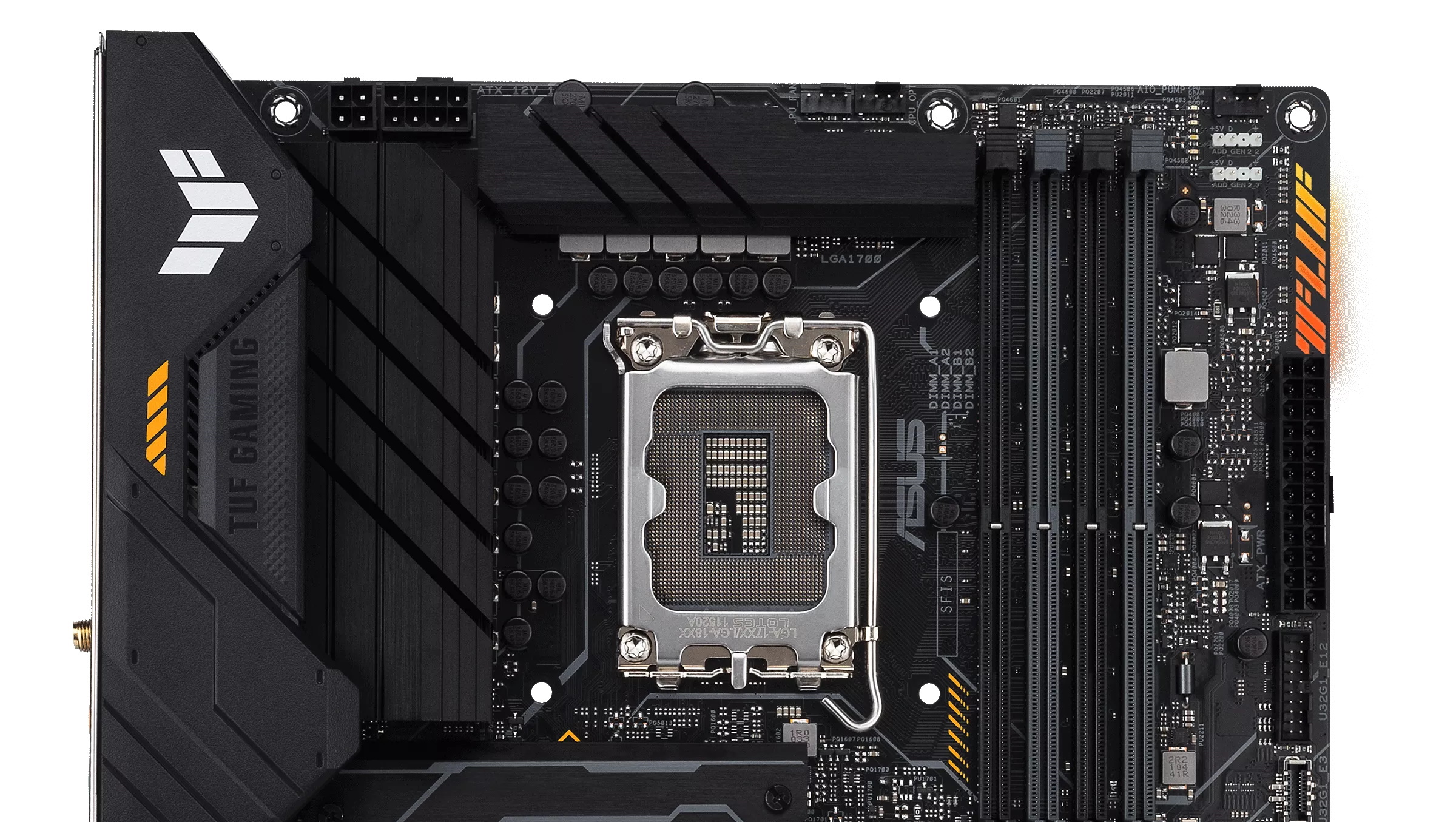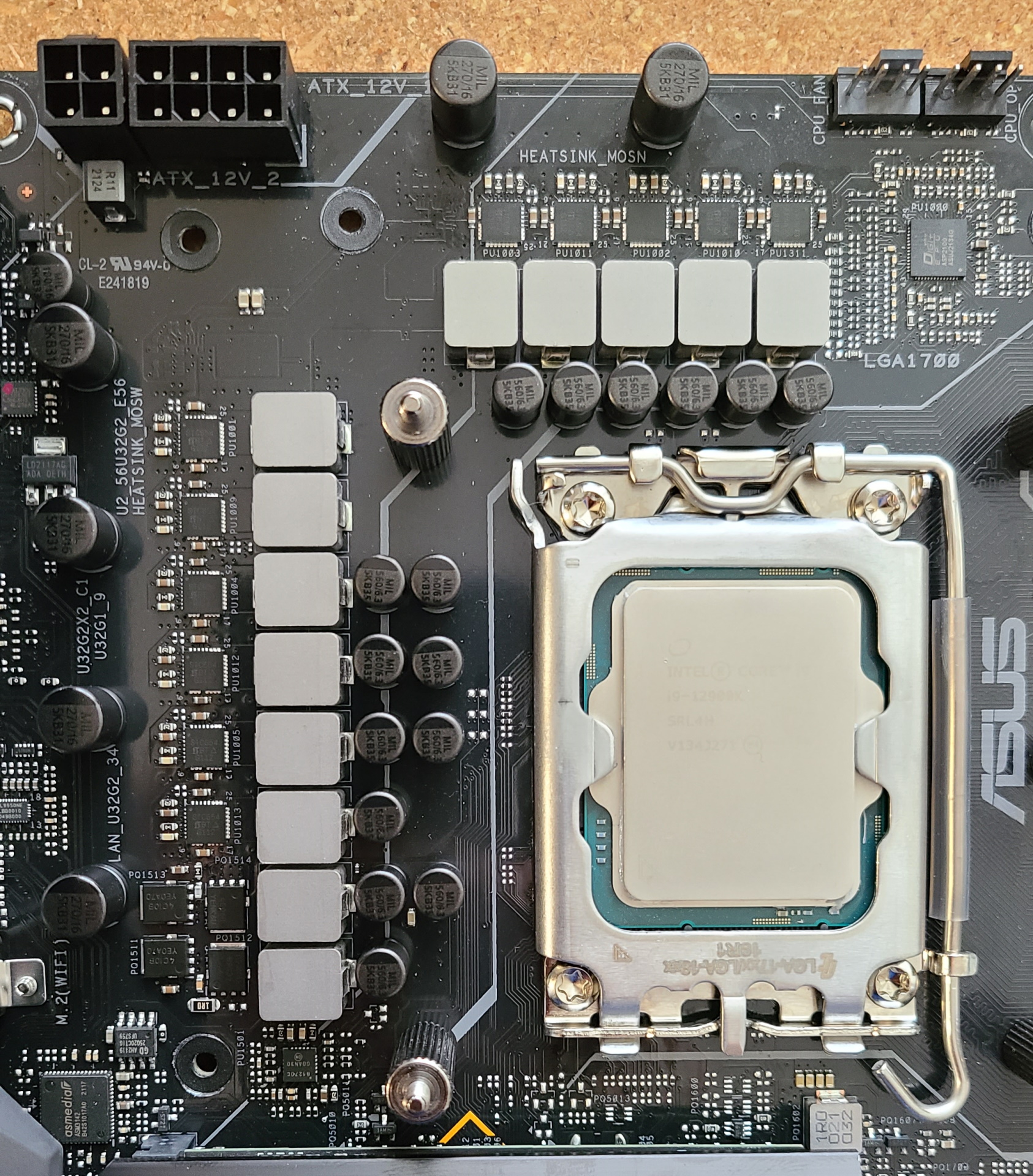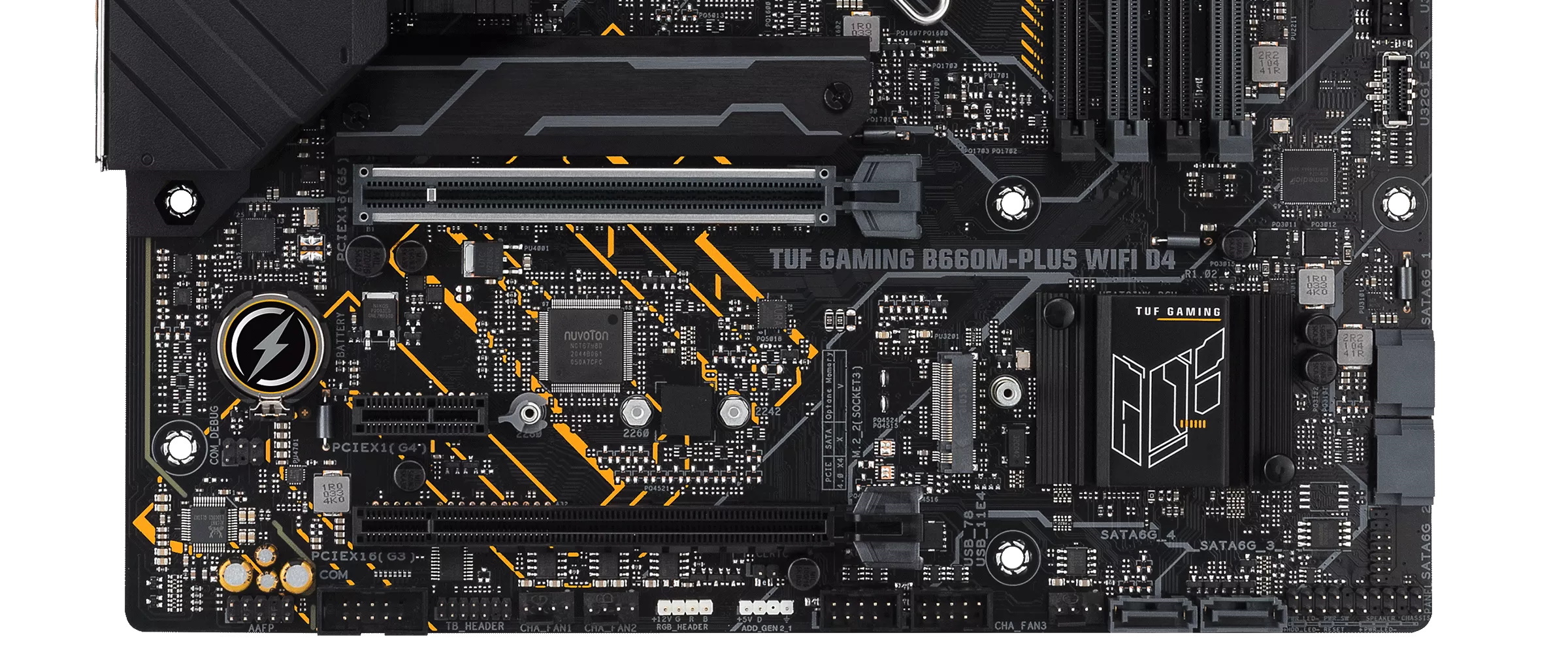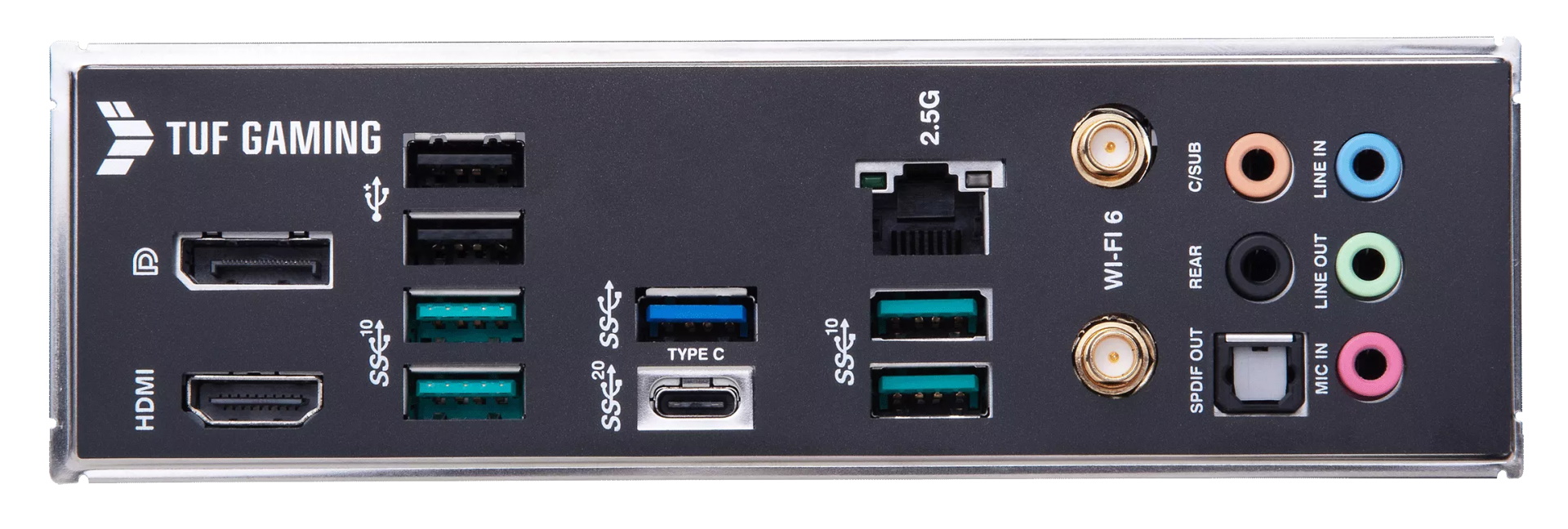Tom's Hardware Verdict
The Asus TUF Gaming B660M-Plus WIFI D4 is a capable board at a reasonable price. You’ll find a 20 Gbps Type-C port on the rear IO, integrated Wi-Fi 6, and enough storage options for most, making it a good option in the budget Micro ATX Alder Lake space.
Pros
- +
20 Gbps Type-C Rear IO port
- +
Good overall performance
- +
Screw-free Q-latch for M.2
Cons
- -
Dated audio codec
- -
‘Only’ four SATA ports
Why you can trust Tom's Hardware
For what we expect to be our last Alder Lake review (Ryzen 7000 arrives later this month, followed at some point by Raptor Lake), we get a chance to look at another Micro ATX B660-based motherboard with the Asus TUF Gaming B660M-Plus WIFI D4. As the name implies, it’s a DDR4 option that includes Wi-Fi 6, two PCIe 4.0 M.2 sockets, a 20 Gbps USB Type-C port, capable power delivery, and even Thunderbolt 4 support (via a header). Priced at $171.99, the B660M-Plus WIFI D4 is a well-appointed motherboard in the budget Micro ATX space vying for your hard-earned system build budget.
Other hardware includes four SATA ports, a 2.5 GbE port, dated Realtek ALC897 audio, and the TUF styling (black with yellow accents). Performance on the TUF Gaming was as expected all around. It was slower than average during heavily multi-threaded testing in Cinebench R23 and POV-Ray multi-core, but nothing terribly out of line. Lightly threaded applications, including the Procyon Office tests and gaming, were faster than average. Overall, this is a performant device compared to other B660 DDR4-based entrants.
We’ll dive headfirst into the details below, including the hardware and performance of our TUF board and see how it stacks up compared to its peers. It certainly has a chance to earn a spot on our best motherboards list. But before we get into all of that, below are the B660M-Plus WIFI D4’s detailed specifications from Asus.
Specifications: Asus TUF Gaming B660M-Plus WIFI D4
| Socket | LGA1700 |
| Chipset | B660 |
| Form Factor | Micro-ATX |
| Voltage Regulator | 11 Phase (10 Vcore, 50A MOSFETs) |
| Video Ports | (1) HDMI (v2.1 - 4K @ 60 Hz) |
| Row 5 - Cell 0 | (1) DisplayPort (v1.4 - 4K @ 60 Hz) |
| USB Ports | (1) USB 3.2 Gen 2x2 (20 Gbps) |
| Row 7 - Cell 0 | (4) USB 3.2 Gen 2 (10 Gbps) |
| Row 8 - Cell 0 | (1) USB 3.2 Gen 1 (5 Gbps) |
| Row 9 - Cell 0 | (2) USB 2.0 (480 Mbps) |
| Network Jacks | (1) 2.5 GbE |
| Audio Jacks | (5) Analog, (1) SPDIF |
| Legacy Ports/Jacks | ✗ |
| Other Ports/Jack | ✗ |
| PCIe x16 | (1) v5.0 (x16) |
| Row 15 - Cell 0 | (1) v3.0 (x4) |
| PCIe x8 | ✗ |
| PCIe x4 | ✗ |
| PCIe x1 | (1) v4.0 (x1) |
| PCIe x1 | (1) v4.0 (x1) |
| CrossFire/SLI | ? |
| DIMM Slots | (4) DDR4 5333+(OC), 128GB Capacity |
| M.2 Sockets | (1) PCIe 4.0 x4 (64 Gbps) / PCIe (up to 80mm) |
| Row 23 - Cell 0 | (1) PCIe 4.0 x4 (64 Gbps) / PCIe (up to 80mm) |
| U.2 Ports | ✗ |
| SATA Ports | (4) SATA3 6 Gbps (Supports RAID 0/1/5/10) |
| USB Headers | (1) USB v3.2 Gen 1, Type-C (5 Gbps) |
| Row 27 - Cell 0 | (1) USB v3.2 Gen 1 (5 Gbps) |
| Row 28 - Cell 0 | (2) USB v2.0 (480 Mbps) |
| Fan/Pump Headers | (6) 4-Pin (CPU, CPU OPT, AIO Pump, Chassis) |
| RGB Headers | (3) aRGB (3-pin) |
| Row 31 - Cell 0 | (1) AURA RGB (4-pin) |
| Diagnostics Panel | Q-LED |
| Internal Button/Switch | ✗ |
| SATA Controllers | ✗ |
| Ethernet Controller(s) | Realtek RTL8125 (2.5 Gbps) |
| Wi-Fi / Bluetooth | Intel AX201 Wi-Fi 6 (2x2 ax, MU-MIMO, 2.4/5/6 GHz, 160 MHz, BT 5.2) |
| USB Controllers | ASMedia ASM1074, ASM2142 |
| HD Audio Codec | Realtek ALC897 |
| DDL/DTS Connect | ✗ / ✗ |
| Warranty | 5 Years |
Inside the Box of the Asus TUF Gaming B660M-Plus WIFI D4
Asus includes several accessories inside the board’s packaging, designed to get you up and running without an additional trip to the store. Nothing stands out in the accessory stack, but it includes a support/driver DVD, SATA cables, and the Wi-Fi antenna. Below is a complete list of the included extras.
- (2) SATA 6Gb/s cables
- ASUS Wi-Fi moving antennas
- M.2 Rubber Package
- M.2 SSD screw package
- TUF Gaming sticker
- Support DVD
- TUF Certification card
- User guide
Design of the TUF Gaming B660M-Plus
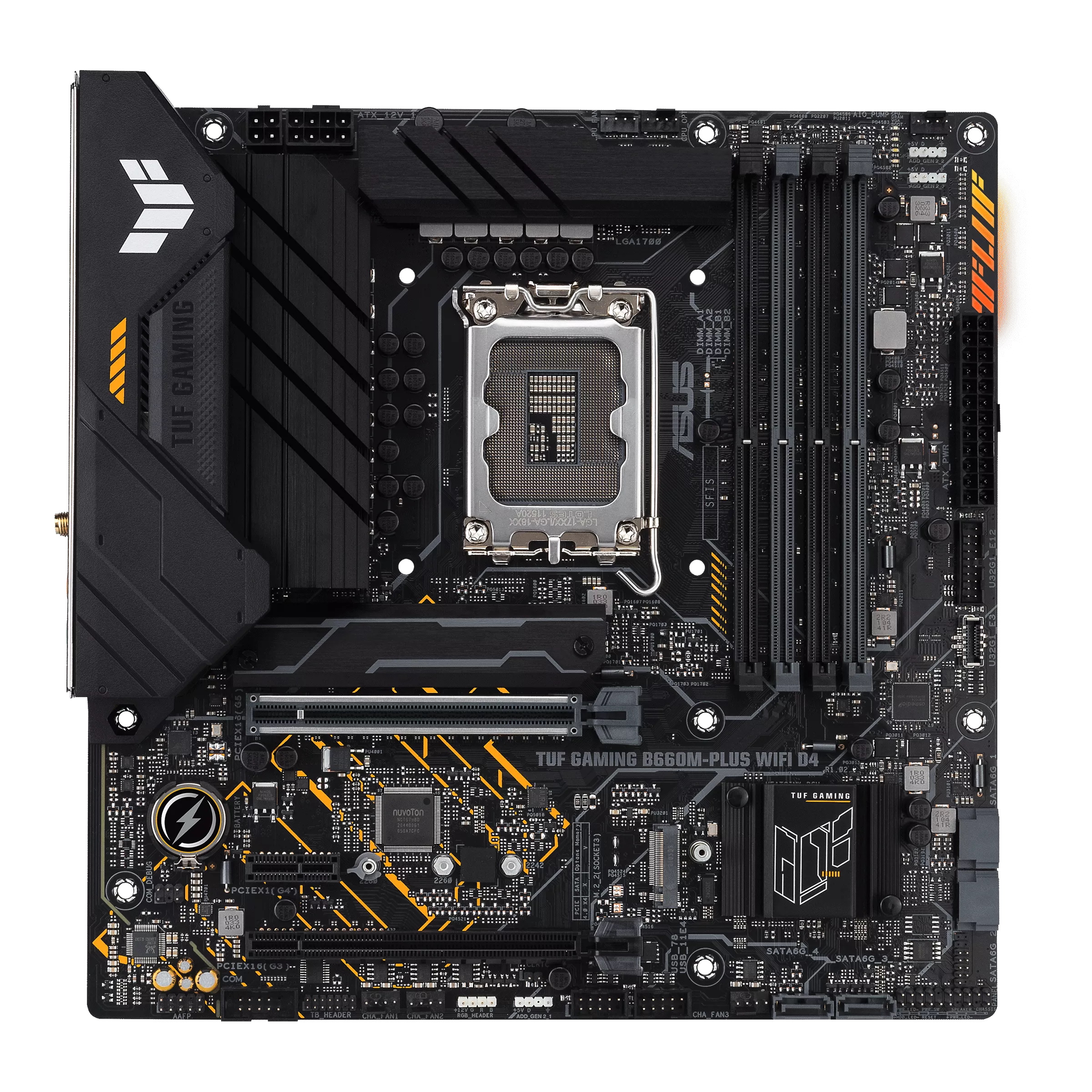
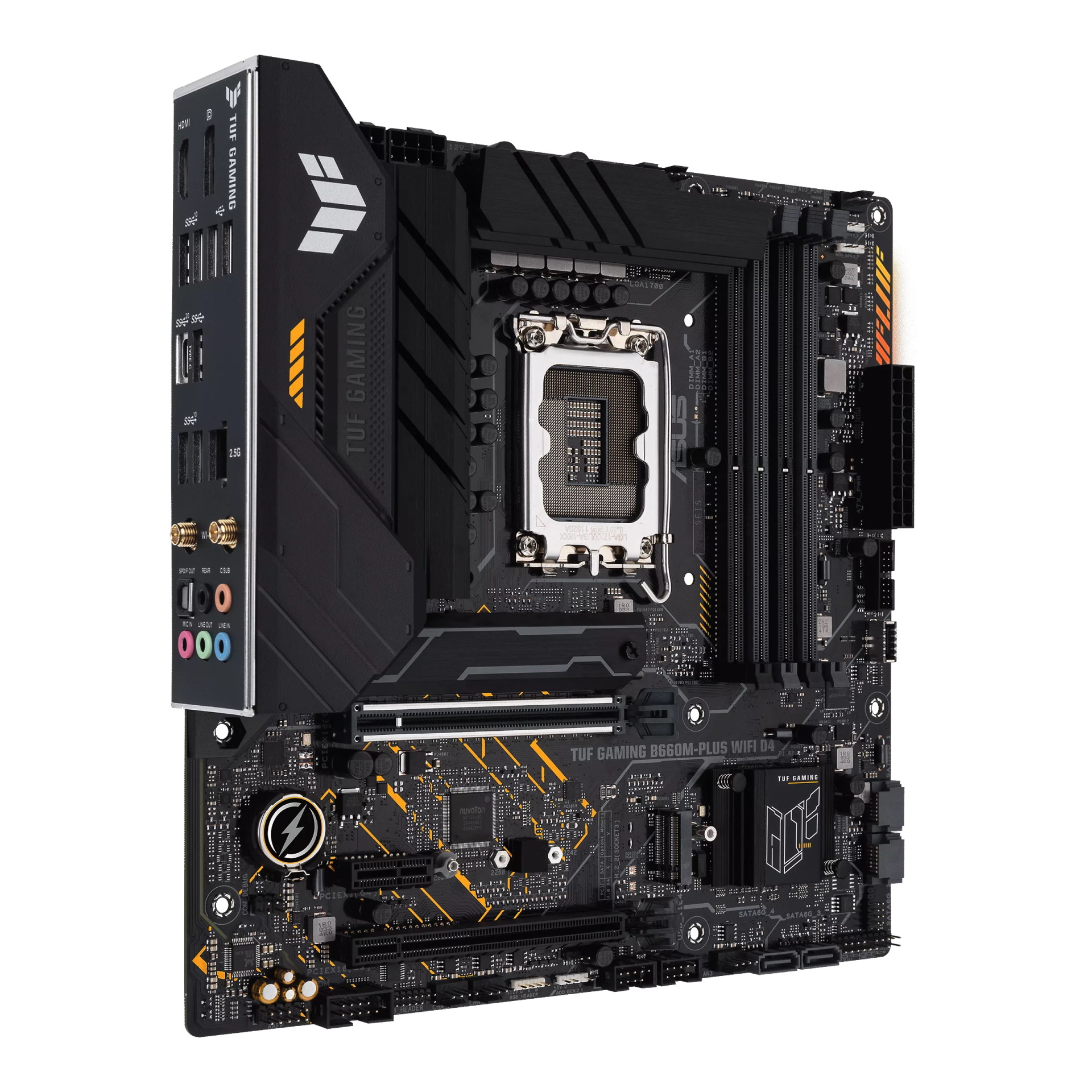
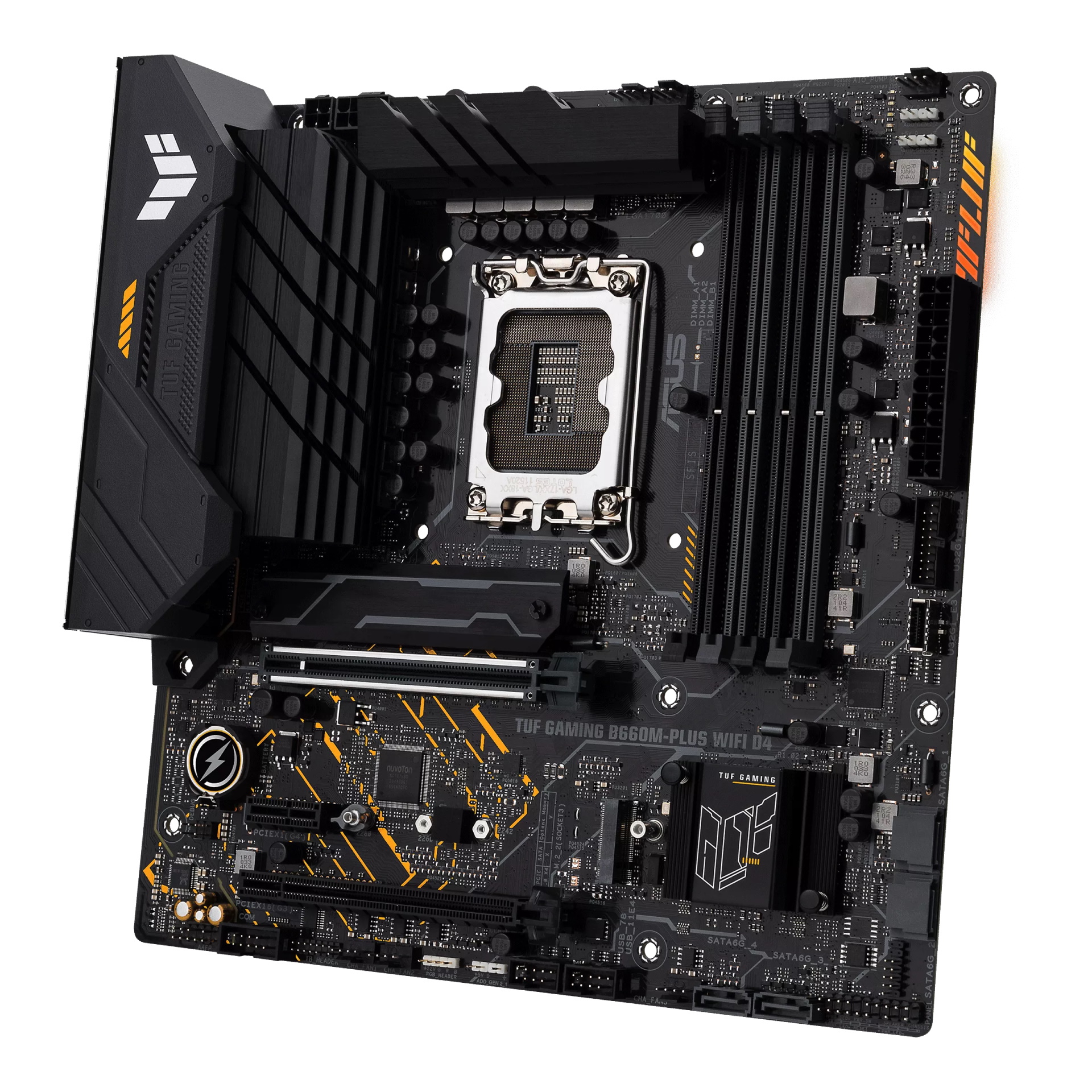
According to Asus, the TUF boards (TUF = The Ultimate Force) are engineered with military-grade components, an upgraded power solution, and a comprehensive cooling solution that’s said to offer rock-solid and stable performance for marathon gaming. While today’s TUF boards are a far cry from those of years past (think about all the armor and the fact they weren’t considered a budget option a few generations ago), but what’s here is still a well-rounded solution. The B660M-Plus WIFI D4 sports the new TUF Gaming logo and simple geometric design elements in yellow around the PCIe/M.2 area. It’s a simple theme that looks to blend in with a lot of build themes.
For those into RGB lighting, the TUF Gaming includes several on the back side of the board, which illuminate the TUF letters through the translucent layers. While it’s not the brightest RGB implementation we’ve seen, there’s enough to show off the board and anything inside the chassis. Overall, the board doesn’t stand out with its looks, but you’ll be happy to show it off inside your case.
In the upper-left corner of the board, the first thing we come across are the solid tine EPS connectors for delivering power to the processor. In this case, there are two: a required 8-pin and an optional 4-pin. Below those are the large heatsinks that cool the 11-phase power delivery. These have a lot of mass and a fair amount of surface area, so it looks like they can keep the power bits below running within spec.
Get Tom's Hardware's best news and in-depth reviews, straight to your inbox.
Above the top VRM heatsink are the first two (of six) 4-pin fan headers. In this area are the CPU_FAN and CPU_OPT headers, both of which automatically detect the type of fan (PWM or DC powered) attached. Output on these (and all) headers is 1A/12W. In addition to the CPU headers, you’ll find three chassis fan headers and another dedicated to the AIO pump (the latter runs at full speed). There are enough fan/pump headers to go around, but I would like to see at least one of them support more than 1A/12W.
Continuing our journey to the right, we run into the four unreinforced DRAM slots, each with single-sided locking mechanisms on the top edge (away from the video card, thankfully). Asus lists support up to DDR4-5333+(OC), similar to the other comparable boards. We ran our two kits without issue, enabling XMP and running our benchmarks and stress tests.
In the upper-right corner is the Q-LED section, with 4-LEDs that light up during the POST process. If there are failures related to Boot, VGA, RAM, or CPU, the corresponding LED remains lit, giving you an idea of where the problem is that’s preventing access to the BIOS or Windows.
If the integrated RGBs don’t provide enough bling out of the box, there are two headers in this area, both 3-pin ARGB. Additionally, there are two more headers along the bottom edge of the board: a third 3-pin ARGB and a 4-pin AURA RGB header.
Moving down the right edge, we get a better look at the TUF design aesthetic, glowing from the RGBs below. Below that is the 24-pin ATX power connector for the board, a 19-pin front panel USB 3.2 Gen 1 (5 Gbps) header, and a USB 3.2 Gen 1 (5 Gbps) Type-C header.
Power delivery for this non-processor overclocking board consists of an 11-phase VRM, with 10 phases dedicated to Vcore, supporting the power-hungry Alder Lake processors. Power comes from the EPS connector(s) onto the DIGI+ 10-channel PWM controller (ASP2100). From there, power heads off to the 10 Vishay 50A Sic654 DrMOS MOSFETs. While the 500A available for Vcore isn’t a lot, it handled our Core i9-12900K without issue. Power delivery was not a limiting factor in our tests.
Sliding down to the bottom half of the board, we’ll start on the left side with the audio section. Here we spy a fully exposed Realtek ALC897 codec to the left of the audio separation line. Four small capacitors dedicated to audio round out this area. Many users find this audio acceptable, but there are similar boards with better codecs.
In the middle of the board, we find the PCIe slots (three) and M.2 sockets (two). Starting with the PCIe slots, the reinforced top slot (the primary video card slot) sources its PCIe 5.0 x16 lanes through the CPU, while the bottom full-length slot gets its PCIe 3.0 x4 lanes from the chipset. The small, closed-end x1 slot runs at PCIe 4.0 x1 speeds and also sources the bandwidth from the chipset.
As we move right, past the pushpin-attached chipset heatsink, we run into the first two SATA ports, with the other two mounted vertically along the bottom edge. If you want to RAID drives on these ports, the B660M-Plus WIFI D4 supports RAID0/1/5/10 modes across all four ports. The manual doesn’t mention any port/lane sharing, so you can run any combination of PCIe/NVMe-based M.2 modules and all four SATA ports concurrently.
Across the bottom are several headers, including USB ports and RGB. Below is a complete list, from left to right:
- Front panel audio
- COM port
- Thunderbolt header
- (2) 4-pin Chassis fan headers
- 4-pin RGB header
- 3-pin ARGB header
- Clear CMOS jumper
- (2) USB 2.0 headers
- System Fan header
- (2) SATA ports
- Front panel header
The rear IO area comes with a pre-installed IO plate with a black background and white labels for the ports. There’s some TUF Gaming branding in the upper-left corner. Otherwise, things are pretty standard. While there aren’t an excessive number of USB ports, most users should find the seven Type-A and one Type-C port enough. There are four 10 Gbps ports, one 5 Gbps port, and two USB 2.0 480 Mbps ports surrounding the 20 Gbps Type-C port. Video outputs consist of the usual: HDMI and DisplayPort. You’ll find the 2.5 GbE port next to the Wi-Fi 6 antenna headers. Last but not least is a full 5-plug plus SPDIF audio stack.
MORE: Best Motherboards
MORE: How To Choose A Motherboard
MORE: All Motherboard Content

Joe Shields is a staff writer at Tom’s Hardware. He reviews motherboards and PC components.
-
Co BIY Thanks for the review!Reply
The affordable motherboards seemed to come very late in the cycle for Alder Lake, I think having the full gamut of 600 series boards available from the start will help Rocket Lake.
I hope you will be able to go back to these boards with a Rocket Lake processor and see if they can handle them as well as Alder Lake.
